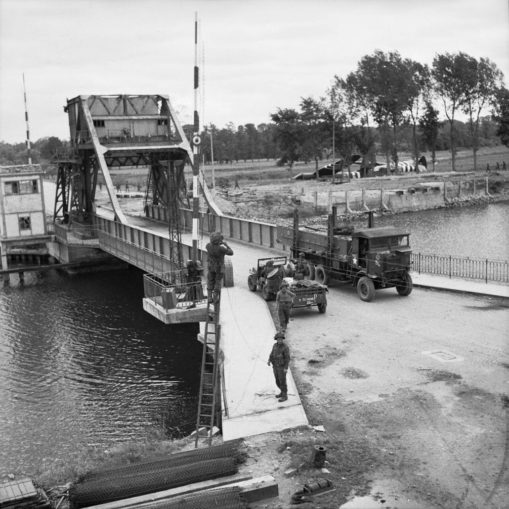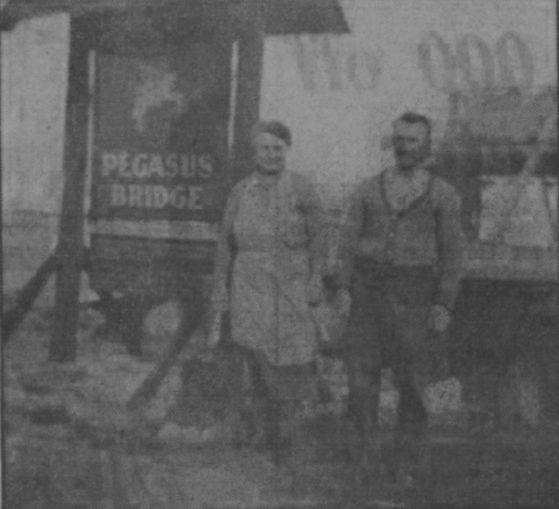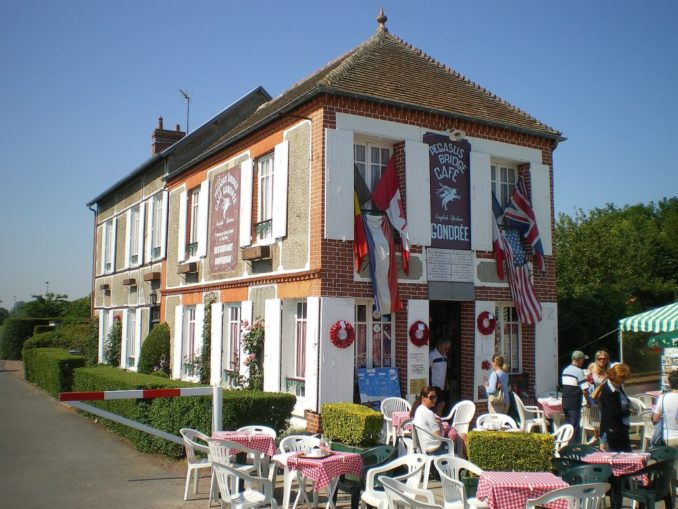In May 1954 my uncle John Alldridge returned to Normandy. This is his report for the Manchester Evening News. The lines at the end are by A E Housman
They are building a new motor road along the coast of Normandy. A road so new that as yet it does not appear on any map.
One day, no doubt, it will cut like a knife through this pleasant country of sand dunes and salt flats and tall pampas grass. And then it will thread all those charming toy-towns with names straight out of a French fairy tale – Courseulles, Ver-sur-Mer, Ouistreham-Riva-Bella, and the rest – into a string of glittering beads. It will be called, of course, La Route de la Liberation.
But that day is still a long way off. Just now what there is of the new road moves in fits and starts. You are for ever reversing, backing out, making wide detours inland.
You bowl along merrily for a mile or two. And then suddenly, without warning, you are brought up short by something barring your way. Something as solid, as implacable, as a stone wall.
Which is exactly what it was. A wall. Hitler’s Atlantic Wall. A barricade of steel and concrete, bristling with blockhouses and redoubts and tank traps.
А wall which ruthlessly absorbed everything into that elaborate defence system – every beach, every cove a barbed-wire entanglement; every seaside town a fortress. Guns sprouted from the very hotel cellars.
Much of that wall has been pulled down. The bathing parties go gaily through the ragged gaps; the beach huts sprout among the minefields; the children build sand castles in the shadow of rusting guns.
But there is enough of it left to make you realise, with a sudden chill, what might have happened if something had gone wrong 10 years ago.
If, for instance, superb Intelligence hadn’t located the weak links in this armour. If Hitler’s fanatical “instinct” hadn’t overruled his generals. If Time and Tide hadn’t been right. If…if…if . . .
And because even the saddest memory cannot last for ever it is good to read in the local guidebook that this Cote de Nacre, from Arromanches to Ouistreham is once more “a spot for a holiday cure, where invalids and children gain lasting health”.
The veterans of D-Day will no doubt smile wryly at that.
And I suppose because in some ghoulish way this sort of thing is good for the tourist trade – these little watering places wear their old battle scars with an almost jaunty air.
Every plage has its gun, its tank, its blockhouse, its personal souvenir de la Liberation.
The most impressive of all these souvenirs still rises and falls with the tide off Arromanches – the fantastic broken half-moon of Mulberry Harbour which the French have affectionately renamed “Port Winston”.
Shortly after the war there was some talk of salvaging this £15m masterpiece. And odd bits of it are doing a useful peacetime job in the most unlikely places.
Some hundreds of yards of it were towed off to Dakar to form a brand new port in the French Cameroons. Another thousand feet now provide extra berthing space at Larne in Northern Ireland.
But the bare bones of Mulberry will probably ride there off Arromanches until time and tide have done their worst.
At low tide whole sections of it lie high and dry on the sand like so many stranded whales. They make wonderful playgrounds for children, who climb happily up and down the landing ladders where once men died.
And after each high tide the sea throws up a little more debris – a salt-caked army boot, a battered jerrican or two.
Local enterprise in the tiny township of Arromanches has certainly made the most of its brief moment of history. On the smart little promenade, its windows framing the whole vast crescent of Mulberry, stands a brand new museum dedicated the events of D-Day.
There you can see a fine scale model of Mulberry in all it glory, together with a photostat enlargement of the famous directive that gave it birth:
They must float up and down with the tide. The anchor problem must be mastered. Let me have the best solution worked out. Don’t argue the matter. The difficulties will argue themselves – W.C.
The French love that. They express their admiration in frequent formidables!
Then there is a remarkable diorama that Blackpool would give its eyes for – a working model of the invasion, complete with dramatic sound effects.
For 20 minutes you watch – and hear – the whole thing reproduced in miniature, from the first sticks of paratroops going down to the final break-out at St. Lo.
This museum – they call it simply and most effectively D-Day – was opened last July. In its first six months 25,000 visitors paid a shilling each to see it. Which suggests that it is going to be a steady source of income for many years yet.
There are other memorials, of course, smaller, more poignant. At Ver-sur-Mer, which future history books will remember as Gold Beach, grateful hands have put up a small sandstone obelisk to the memory of Colonel J. R. Harper and the 2nd Battalion the Hertfordshire Regiment – a Territorial battalion – “who freed our commune at dawn on June 6, 1914.”
Courseulles, with its oyster beds once more flourishing, will always be sacred to the Canadians, who on Juno Beach took their own personal revenge for the shambles of Dieppe. And the sentimental French, who love a gallant feat-of-arms, have noted it and marked the spot.
But all this happened quite a long time ago. Human memories are short. And the war left marks on Normandy that will still be there when the events of D-Day are just so many lines in the history books.
I was shocked to see how much private property has been left derelict, as if the owners had not the heart to return.
All along this coast are the remains of trim little villas that took the first hammer-blows of liberation and never survived.
On the walls of on ruined doll’s house near Lue someone has recently painted the mute appeal Paix!
In every sea side town are the splintered shells of hotels which have seen no life for more than ten years.
From the sea, Bernieres, once a hotly contested strong-point looks very much as it must have done to those Canadian Commandos, crouched in their landing-craft in the cold dawn light of D-Day.
And you hear much bitter talk of promises unfulfilled, or war damage claims that have never been settled or dismissed on some legal quibble.
But not everyone has forgotten . . . . About two miles from the sea, where the coast road swings left to follow the canal into Caen, is an iron swing-bridge.
Since 1944 that bridge has had a new name – Pegasus. It will stand forever now to the memory of the men of the 5th Parachute Brigade.
Men from Lancashire and Yorkshire mostly, who in the early hours of June 6, 1944, took and held that bridge until their comrades, Commandos of the 1st Special Service Brigade, fighting their way in from the beaches, could join up with them.

Christie (Sgt), No 5 Army Film & Photographic Unit, Public domain, via Wikimedia Commons
At the bridgehead is a small corner cafe that proudly carries as its signboard the pale blue Pegasus badge of the Airborne.
And there you will find Monsieur and Madame Gondrée.

The Gondrées were the first French citizens to be liberated by the British Army. And they have a certificate from the British Government to prove it.

Rundvald, Public domain, via Wikimedia Commons
Madame Gondree has it hanging now in the place of honour in her small parlour, together with a group photograph – taken just before D-Day – of her braves, the 12th (Yorkshire) Battalion .
During the fighting for the bridge Madame tended the wounded in her cellar while Monsieur “refreshed” the rest with 97 bottles bottles of vintage champagne set aside for the day of liberation.
Many of those boys now lie in the quiet little war cemetery at Ranville, on the other side of the canal.
Madame will take you down into that cellar and point dramatically to the spot on the earth floor where France was liberated.
And listening to her you can see it all. That French family sheltering there behind the huge wine casks. And out in the darkness among the gooseberry bushes the English voices calling.
And then the cellar door opening suddenly and there, silhouetted against the dawn light, the giant with the blackened face and the red beret.
The giant who gave the “V” sign and shouted over and over again almost all the French he knew “Victoire . . . . victoire” and spinning down an English half crown to prove it.
He came from Lancashire, she believes. His red beret hangs now on the parlour wall. And each Sunday Madame crosses the bridge to tend his grave in the little cemetery at Ranville.
“You see, I am all the family he has. He was so young, so gentil. And now he lies over there with his friends. He would be glad to know that some of us still remember.”
Yes, Madame, he would be glad to know that he is still remembered.
And standing there in that cellar, where one morning a door suddenly opened and let the free world in, I found myself remembering some words I had seen in another place far from here. Words carved in enduring stone:
Here dead lie we because we did not choose
To live and shame the land from which we sprung,
Life to be sure is nothing much to lose,
But young men think it is, and we were young.
Jerry F 2021



